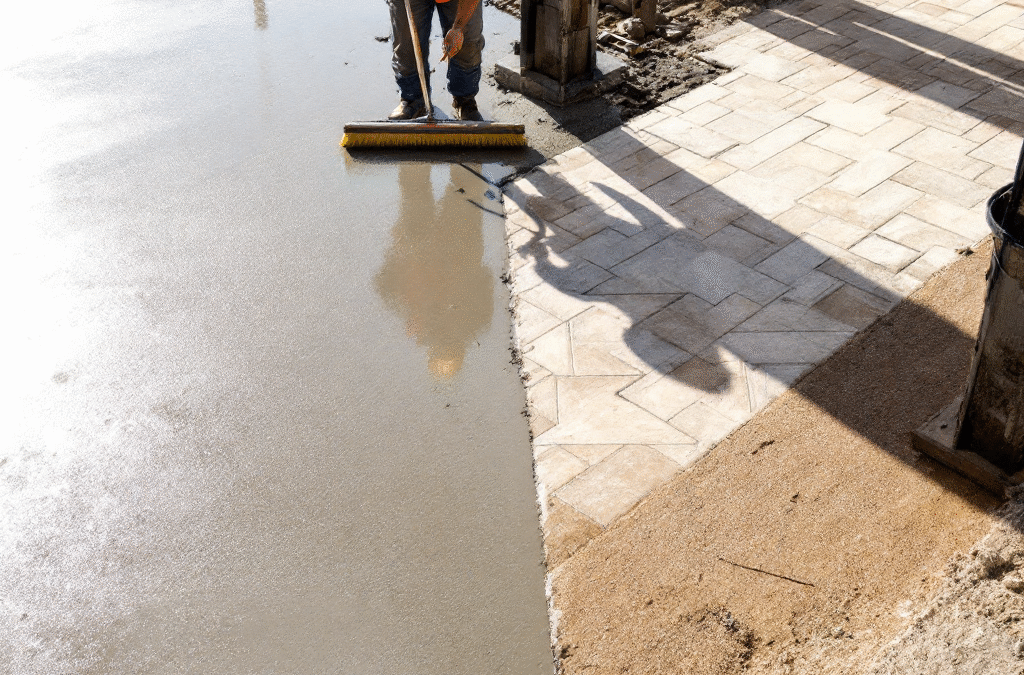I. Introduction
Concrete finishes play a crucial role in the overall success of commercial construction projects. They not only enhance the aesthetic appeal of the structures but also contribute to their durability and functionality. Selecting the right finish can elevate the performance of concrete in both high-traffic and decorative applications, making it critical for architects and builders to understand their options.
II. Types of Commercial Concrete Finishes
A. Broom Finish
A broom finish is achieved by dragging a broom over freshly poured concrete before it sets, creating a textured surface. This technique is popular due to its slip-resistant qualities, making it ideal for outdoor applications such as walkways, patios, and pool decks. Additionally, a broom finish is cost-effective and provides adequate traction, ensuring safety in high-traffic areas.
B. Polished Concrete
Polished concrete involves grinding the surface of the concrete and applying a polishing process to achieve a smooth, high-gloss finish. This finish is increasingly favored in office buildings and retail environments due to its elegant appearance and easy maintenance. The reflective surface of polished concrete can enhance lighting in large spaces, making it a popular choice among designers aiming for a modern aesthetic.
For more on installation considerations, read our guide on commercial concrete installation.
C. Exposed Aggregate Finish
An exposed aggregate finish is achieved by removing the top layer of cement paste to reveal the underlying aggregates, such as stones or pebbles. This technique not only elevates the visual appeal of the concrete but also improves its durability and slip-resistance. Exposed aggregate is commonly used in outdoor settings, including sidewalks and driveways, where both beauty and functionality are paramount.
D. Stained Concrete
Stained concrete involves applying chemical or water-based stains to enhance the color and appearance of the concrete. There are two primary types of stains: acid-based, which create rich, variegated colors, and water-based, which offer a wider palette of hues. Staining is suitable for various applications, including retail and event spaces, where aesthetics play a significant role in attracting customers.
E. Stamped Concrete
Stamped concrete is created by imprinting a pattern or texture into the surface of fresh concrete using specialized mats. This technique allows for a wide range of designs, including brick, stone, and tile patterns, making it versatile for commercial settings like outdoor plazas and entranceways. The durable nature of stamped concrete, combined with its visual appeal, makes it an attractive option for enhancing the exterior of buildings.
F. Trowel Finish
A trowel finish is accomplished by using a trowel to smooth the surface of freshly poured concrete. This technique is often used in areas requiring a flatter surface, such as floors in warehouses or industrial spaces. The simplicity and effectiveness of trowel finishes make them a reliable choice for many commercial projects, providing a clean, professional look.
Be sure to avoid these common mistakes in concrete construction.
G. Sealed Finish
Sealing concrete is essential for protecting it from moisture, stains, and wear. Various types of sealers are available, including penetrating sealers that provide internal protection and topical sealers that create a film on the surface. A sealed finish enhances the longevity and appearance of concrete while making it easier to clean, making it a critical consideration in commercial projects.
Learn more about curing times for commercial concrete and sealing practices.
III. Factors to Consider When Choosing a Concrete Finish
A. Purpose of the Space
When selecting a concrete finish, understanding the purpose of the space is paramount. The functional requirements will vary significantly depending on whether the area is designated for retail, office, or industrial use. For instance, a busy retail space may benefit from a polished finish that reflects light and enhances aesthetics, while a warehouse may require a more durable and less glossy surface.
Check out our comparison of residential vs. commercial applications for more insights.
B. Environmental Considerations
Environmental factors play a significant role in the choice of concrete finishes. Indoor applications may prioritize aesthetics and easy maintenance, while outdoor projects must consider weather resistance and durability. A finish that withstands extreme weather conditions is crucial for outdoor environments to ensure longevity and reduce maintenance costs.
See how weather affects your concrete pour during any season.
C. Aesthetic Preferences
Architectural design greatly influences the choice of concrete finishes, necessitating a consideration of color and texture. A finish should not only complement the overall style of the building but also create a welcoming atmosphere for visitors. Incorporating unique color options and textures can help to align the concrete finish with the facility’s branding and overall design vision.
IV. Benefits of Proper Concrete Finishing
A. Enhanced Durability
Properly finished concrete can withstand high traffic and varying environmental conditions, significantly enhancing its durability. The right finish can also prevent cracking, chipping, and staining, extending the life of the concrete installation. This durability not only saves on repair costs but also reduces the frequency of resurfacing.
Understand the importance of reinforcement in improving durability.
B. Improved Aesthetics
A well-chosen concrete finish elevates the visual appeal of any commercial project. By harmonizing with the architectural style and meeting the client’s preferences, the selected finish can greatly enhance the property’s overall appearance. Investing in aesthetics can attract customers and clients, making the space more inviting and professional.
C. Ease of Maintenance
Different finishes come with varying maintenance requirements, but many modern applications, like polished concrete and sealed finishes, are designed for minimal upkeep. The ease of cleaning and maintenance can significantly reduce long-term operational costs. Facilities with low-maintenance finishes are often more appealing to businesses looking for efficiency.
D. Safety Features
Safety is another critical factor in selecting a finish for concrete. Many finishes can provide slip resistance, which is essential in preventing accidents in high-traffic commercial areas. Incorporating safety features into the finish design enhances the overall usability of the space, ensuring visitor safety remains a top priority.
Explore key safety measures to consider before finishing your project.
V. Case Studies of Commercial Projects
A. Example 1: Retail Space with Broom Finish
A retail location implemented a broom finish for its outdoor walkways to ensure slip resistance during rainy weather. The texture not only enhanced safety but also blended seamlessly with the surrounding landscaping, providing an inviting entrance for shoppers. This practical decision helped the business maintain an appealing exterior while prioritizing customer safety.
B. Example 2: Polished Concrete in Office Buildings
In a modern office building, the use of polished concrete flooring created a sleek, professional ambiance while reflecting natural light to enhance the workspace. The low-maintenance nature of polished concrete also reduced cleaning costs, allowing the facility management to allocate resources elsewhere. This approach contributed to a vibrant office environment that appeals to employees and clients alike.
C. Example 3: Stamped Concrete in Outdoor Walkways
A public plaza utilized stamped concrete to mimic the appearance of natural stone, creating a visually striking and cohesive outdoor space. The patterned surface enhanced the overall aesthetics of the area, making it an attractive destination for visitors. Additionally, the stamped finish offered durability and required minimal upkeep—ideal for a high-traffic urban setting that demanded both beauty and practicality.
VI. Conclusion
Concrete finishes are far more than a visual detail—they’re a key component in the functionality, safety, and longevity of any commercial construction project. From the cost-effective durability of broom finishes to the sleek professionalism of polished concrete, each option serves a unique purpose based on the space’s needs and design goals. Choosing the right finish not only enhances a building’s appearance but also ensures it meets the demands of everyday use while standing the test of time. Whether you’re aiming to impress clients, improve safety, or simplify maintenance, there’s a concrete finish tailored to your project.
Ready to enhance your commercial property with the perfect concrete finish?
CALL US NOW TO GET A QUOTE and bring your vision to life.


